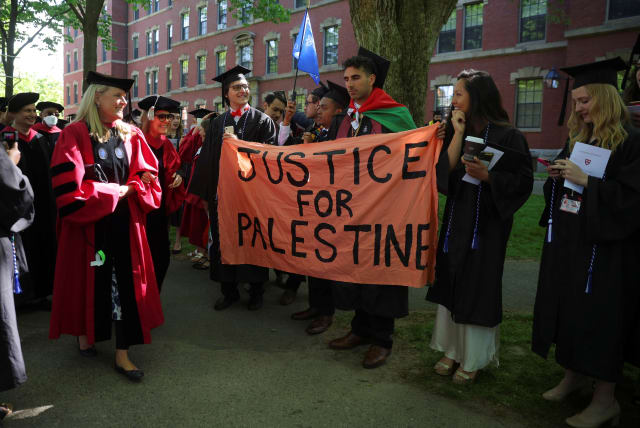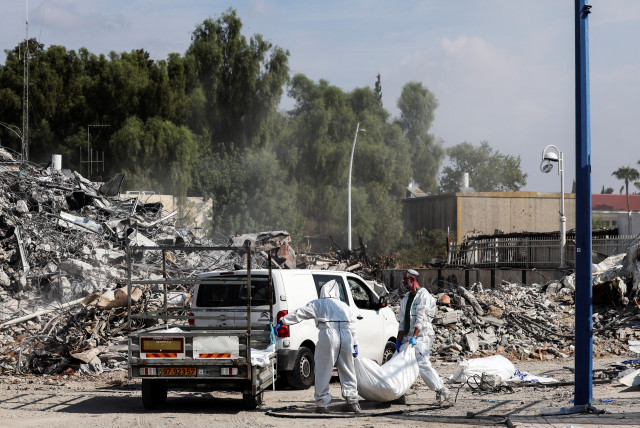Harvard and Israel’s war with Hamas - opinion

Harvard student groups claimed Hamas’s attack “did not happen in a vacuum,” and were the result of Israeli occupation in an open letter.
What’s with those Harvard University students when it comes to Israel? In the face of Hamas’s murderous attacks in Israel, 33 Harvard University student organizations consider Israel “entirely responsible” for the attacks.
These student organizations, among them an affiliate of Amnesty International, blamed the Jewish state in a letter titled “Joint Statement by Harvard Palestine Solidarity Groups on the Situation in Palestine.” This letter was issued at a time when hundreds of Israelis and tourists had been murdered and more than a hundred, including children, were being dragged into Gaza to be held as hostages.
The groups claim Hamas’s attack “did not happen in a vacuum,” and the Israeli government has forced Palestinians to live in an “open-air prison for over two decades.”
But this is not the first time that Harvard’s students have picked the wrong side to back. In 2014, Harvard University students visiting the Palestinian Authority posed, smiling, at Yasser Arafat’s grave. That visit, I wrote in 2014, “sent a shot of pain through every one of us who has lost a loved one in the terrorist attacks that Arafat and his allies have waged over the years.”
What makes the Harvard students’ letter especially appalling is that some of Harvard’s own students have been victims of Palestinian terrorism.
Harvard student Etan Bard and his father, Seldon, were murdered by Palestinian terrorists who blew up a TWA flight from Israel in 1974. Harvard alumnus Harold Rosenthal, who had served as an aide to US senators Walter Mondale and Jacob Javits, was murdered by Palestinian terrorists in the Istanbul airport attack in 1976. Another Harvard graduate, Dr. Alan Bauer, was severely wounded – as was his then 7-year-old son who was permanently maimed – in a Palestinian suicide bombing in Jerusalem in 2002.
Perhaps these student groups simply feel that they are following in the university’s footsteps as it seeks to have relationships with Palestinian universities.
For instance, Harvard’s then-president Lawrence Bacow recently paid a friendly visit to Al Quds University, near Jerusalem. According to an Al Quds press release, “he met some of the students and faculty, who expressed their enthusiasm about collaborating with Harvard on future research and educational projects.”
I wonder if Bacow had a chance to discuss with the students another topic about which they are very enthusiastic – glorifying Palestinian Arab terrorists, including murderers of Americans.
For instance, in 2016, the Al Quds University administration organized a “chain of readers” to publicly honor the multiple-murderer Baha Alyan. A few months earlier, Alyan and an accomplice boarded a Jerusalem bus and began attacking passengers. One of those he murdered was a 78-year-old American Jewish civil rights activist from Connecticut, Richard Lakin. Alyan stabbed and shot the defenseless elderly man in his face and chest. More than 2,500 students participated in this celebration of terror.
I ALSO wonder if Bacow had a chance to visit the monument that was erected at Al Quds a few years ago by the student branch of the Popular Front for the Liberation of Palestine (PFLP) terrorist group, a US-designated terrorist group. The campus monument was called the “Monument to the Martyrs of Al-Quds University.” It features this inscription: “Beware of natural death; do not die, but amidst the hail of bullets.” It lists the names of university alumni who were killed while carrying out terrorist attacks.
In addition to Al Quds University, Harvard’s FXB Center for Health and Human Rights launched its collaborative new course on “Palestine Social Medicine” course at Birzeit University despite that institution’s long history of glorifying terrorism.
Here are just two examples:
A basketball championship game under the auspices of the university’s Sports Education Club, to honor Marwan Barghouti, who is serving multiple life sentences in Israel for five murders. The players wore shirts bearing a photo of Barghouti, and the winners received trophies – from Barghouti’s wife – featuring text calling for his release from jail.
Students representing the terrorist groups Hamas and the Popular Front for the Liberation of Palestine were permitted to stage military parades on campus. They marched with facsimiles (hopefully) of bombs and rockets. They held posters featuring the likenesses of the founders of Hamas and the PFLP and waved the official flags of the two terrorist groups.
No American university should be building ties to Palestinian Arab institutions that glorify terrorism. Any relationship gives the Arab university a measure of credibility and prestige that it does not deserve.
Commenting on the letter, former Harvard president and US Treasury secretary Larry Summers wrote in a post on X, formerly known as Twitter, that he was “sickened” by it.
“The silence from Harvard’s leadership, so far, coupled with a vocal and widely reported student groups’ statement blaming Israel solely, has allowed Harvard to appear at best neutral towards acts of terror against the Jewish state of Israel,” he wrote.
While the outpouring of disgust by Summers and others over the Harvard students’ actions is welcome, I’m sure it will not bring an end to Israel-hatred on the campus. Harvard University has a job to do. And I wish they’d get to it.
The writer is president of the Religious Zionists of America (RZA). He is the father of Alisa Flatow, who was murdered in an Iranian-sponsored Palestinian terrorist attack in 1995 and the author of A Father’s Story: My Fight for Justice Against Iranian Terror.
Note: The RZA is not affiliated with any American or Israeli political party.
Jerusalem Post Store
`; document.getElementById("linkPremium").innerHTML = cont; var divWithLink = document.getElementById("premium-link"); if (divWithLink !== null && divWithLink !== 'undefined') { divWithLink.style.border = "solid 1px #cb0f3e"; divWithLink.style.textAlign = "center"; divWithLink.style.marginBottom = "15px"; divWithLink.style.marginTop = "15px"; divWithLink.style.width = "100%"; divWithLink.style.backgroundColor = "#122952"; divWithLink.style.color = "#ffffff"; divWithLink.style.lineHeight = "1.5"; } } (function (v, i) { });

